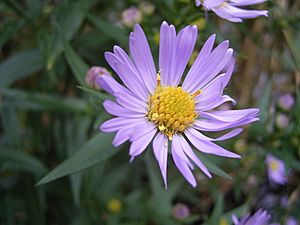New York aster facts for kids
Quick facts for kids New York aster |
|
|---|---|
 |
|
| New York aster | |
| Scientific classification | |
| Synonyms | |
|
Symphyotrichum novi-belgii, the New York aster, is a species of flowering plant. It is the type species for Symphyotrichum, a genus in the family Asteraceae, whose species were once considered to be part of the genus Aster. Plants in both these genera are popularly known as Michaelmas daisy because they bloom around September 29, St. Michael’s Day.
The Latin specific epithet novi-belgii (literally "New Belgium") refers to the 17th century Dutch colony New Netherland which was established on land currently occupied by New York State.
Symphyotrichum novi-belgii grows in abandoned fields and wet meadows in eastern Canada and the northeastern United States.
Distribution
- Native
-
- Nearctic
- Eastern Canada: New Brunswick, Newfoundland, Nova Scotia, Prince Edward Island, Quebec
- Northeastern United States: Connecticut, Maine, Massachusetts, New Hampshire, New York, Rhode Island, Vermont
- Southeastern United States: Delaware, Georgia, Maryland, North Carolina, South Carolina, Virginia
Source: GRIN
Cultivation
This is the largest group of Michaelmas daisies, with over 1,000 named cultivars. They are valued for their late summer color in shades of blue, pink and white. They are best planted in an open, sunny position. While extremely tough, they are susceptible to fungal infections, especially if conditions are not ideal. The cultivars 'Coombe Fishacre' and 'Fellowship' has gained the Royal Horticultural Society's Award of Garden Merit.
Etymology
The Latin-derived specific epithet Novi-belgii means "from New York", which was formerly named Novum Belgium ("New Belgium").

